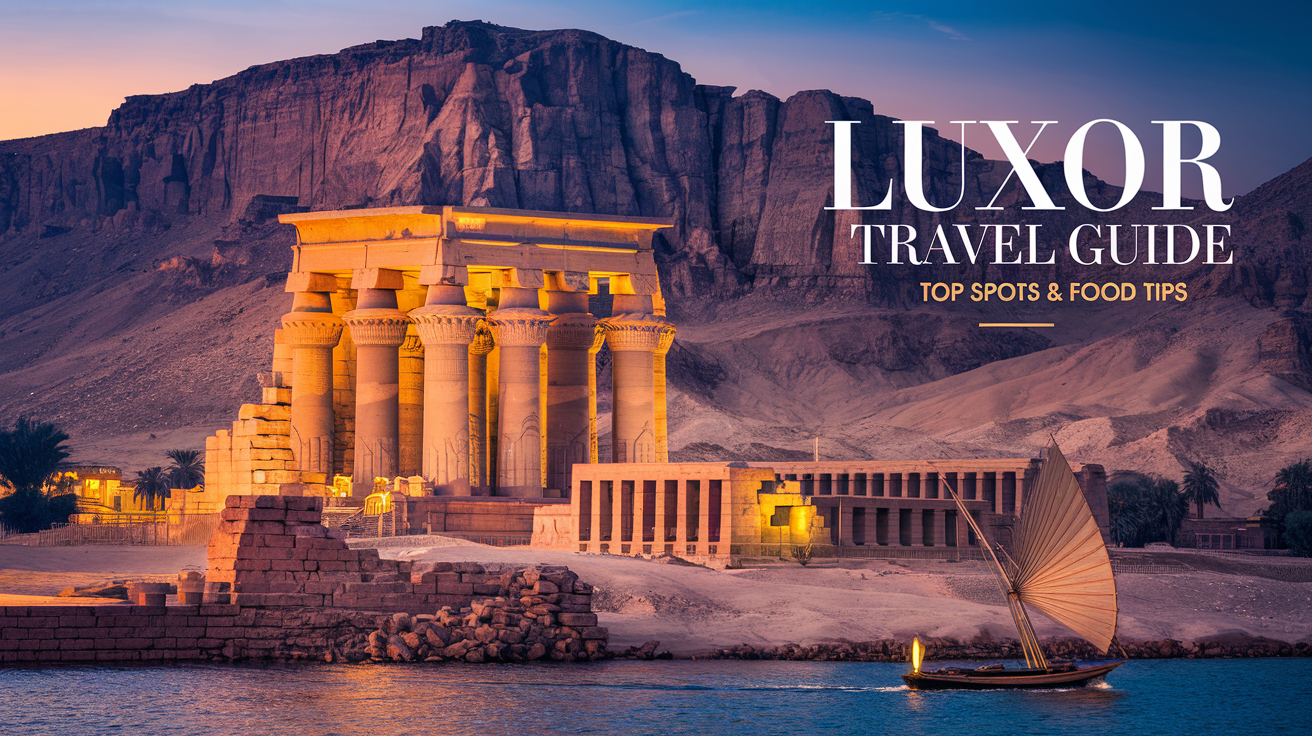Luxor, often referred to as the world’s greatest open-air museum, is a treasure trove of ancient Egyptian history and culture. With its monumental temples, sprawling tomb complexes, and stunning Nile views, Luxor is a dream destination for history enthusiasts and travelers alike. Here’s part one of our guide to Luxor’s top 20 attractions to help you plan an unforgettable visit.
1. Karnak Temple Complex
Description: The Karnak Temple Complex is one of the largest and most impressive religious sites in the world. It features towering columns, intricately carved hieroglyphs, and massive statues dedicated primarily to Amun-Ra, the chief deity of ancient Egypt.
History: Built over 2,000 years, beginning in 2000 BCE, Karnak served as a major center of worship and was expanded by numerous pharaohs, including Ramses II and Hatshepsut.
Google Maps Link: Karnak Temple
Official Website: Karnak Temple
Ticket Prices:
– General admission: 200 EGP (Egyptians: 10 EGP).
– Light and Sound Show: 250 EGP.
Opening Hours:
– Daily: 6:00 am – 5:30 pm.
Travel Options:
– By taxi: Approximately 10 minutes from Luxor city center.
– By horse carriage: A traditional and scenic option from downtown Luxor.
Nearby Restaurants:
– El Hussein Restaurant – Known for its authentic Egyptian dishes, including koshari and grilled meats.
– Sofra Restaurant & Café – Offers traditional Egyptian cuisine in a cozy, heritage-style setting.
Additional Tips: Visit in the early morning or late afternoon to avoid crowds and heat. Don’t miss the Avenue of Sphinxes, which connects Karnak to Luxor Temple.
2. Luxor Temple
Description: A magnificent temple located on the east bank of the Nile, Luxor Temple is renowned for its grand pylons, colossal statues, and stunning reliefs depicting the Opet Festival.
History: Constructed around 1400 BCE during the reigns of Amenhotep III and Ramses II, Luxor Temple was dedicated to the rejuvenation of kingship and played a vital role in religious ceremonies.
Google Maps Link: Luxor Temple
Official Website: Luxor Temple
Ticket Prices:
– General admission: 160 EGP (Egyptians: 10 EGP).
Opening Hours:
– Daily: 6:00 am – 9:00 pm.
Travel Options:
– By taxi: A 5-minute ride from the city center.
– On foot: Located in the heart of Luxor.
Nearby Restaurants:
– Al-Sahaby Lane Restaurant – Famous for its rooftop dining and dishes like falafel and stuffed pigeons.
– Jewel of the Nile – Offers international and Egyptian cuisines in a relaxed setting.
Additional Tips: Luxor Temple is stunningly illuminated at night, making evening visits particularly enchanting.
3. Valley of the Kings
Description: A sprawling necropolis on Luxor’s west bank, the Valley of the Kings is home to the tombs of Egypt’s most powerful pharaohs, including Tutankhamun, Seti I, and Ramses VI. The vibrant wall paintings are a highlight.
History: Used as a royal burial ground from the 16th to the 11th century BCE, the valley contains over 60 tombs, showcasing ancient Egyptian funerary practices and art.
Google Maps Link: Valley of the Kings
Official Website: Valley of the Kings
Ticket Prices:
– General admission: 260 EGP (Egyptians: 20 EGP).
– Tutankhamun’s Tomb: Additional 300 EGP.
Opening Hours:
– Daily: 6:00 am – 5:00 pm.
Travel Options:
– By taxi: 30 minutes from Luxor city center.
– By tour: Many guided tours include transportation and expert commentary.
Nearby Restaurants:
– Africa Restaurant – Known for its friendly ambiance and traditional Egyptian meals.
– Sunflower Restaurant – Offers hearty Egyptian dishes with great views of the Nile.
Additional Tips: Wear sturdy shoes for walking and bring a flashlight to explore darker tombs. Arrive early to beat the heat and crowds.
4. Valley of the Queens
Description: A burial site for queens and royal children, the Valley of the Queens features elaborately decorated tombs, including the stunning Tomb of Nefertari, often called the Sistine Chapel of ancient Egypt.
History: The valley served as a burial ground from the 18th to 20th Dynasties, reflecting the high status of royal women during ancient Egypt’s New Kingdom.
Google Maps Link: Valley of the Queens
Official Website: Valley of the Queens
Ticket Prices:
– General admission: 100 EGP (Egyptians: 10 EGP).
– Tomb of Nefertari: Additional 1,400 EGP.
Opening Hours:
– Daily: 6:00 am – 5:00 pm.
Travel Options:
– By taxi: 30 minutes from Luxor city center.
– By tour: Often included in packages with the Valley of the Kings.
Nearby Restaurants:
– El Nakhil Restaurant – Offers local specialties and stunning views of the surrounding mountains.
– Cleopatra Restaurant – Known for its fresh seafood and Egyptian-inspired dishes.
Additional Tips: The Tomb of Nefertari requires a separate ticket, but its exquisite art makes it worth the splurge.
5. Hatshepsut Temple (Deir el-Bahari)
Description: A magnificent mortuary temple built into the cliffs, Hatshepsut Temple is dedicated to the only female pharaoh to rule Egypt. Its three terraces and grand colonnades make it an architectural masterpiece.
History: Constructed in the 15th century BCE, the temple showcases the power and legacy of Hatshepsut, who portrayed herself as a male to legitimize her reign.
Google Maps Link: Hatshepsut Temple
Official Website: Hatshepsut Temple
Ticket Prices:
– General admission: 140 EGP (Egyptians: 10 EGP).
Opening Hours:
– Daily: 6:00 am – 5:00 pm.
Travel Options:
– By taxi: 25 minutes from Luxor city center.
– By tour: Often combined with the Valley of the Kings and Queens.
Nearby Restaurants:
– El Fayrouz Restaurant – Offers traditional Egyptian food and vegetarian options.
– Marsam Hotel Restaurant – A historical spot serving Egyptian dishes with a side of local charm.
Additional Tips: Visit in the late afternoon to enjoy cooler temperatures and dramatic lighting on the cliffs.
Travel Tips:
Best Time to Visit:
– Early morning to avoid heat and crowds, especially for outdoor sites like the Valley of the Kings and Hatshepsut Temple.
– Evening for illuminated attractions like Luxor Temple.
Transportation:
– Taxis and horse carriages are widely available and convenient. Many sites are included in guided tours for ease of access.
Local Cuisine to Try: Sample Egyptian classics like koshari, falafel, and molokhia at the recommended restaurants.
6. Medinet Habu (Mortuary Temple of Ramses III)
Description: Medinet Habu is an expansive mortuary temple complex dedicated to Ramses III. Known for its towering pylons and vivid wall reliefs, it provides insight into ancient Egyptian warfare, rituals, and daily life.
History: Built during Ramses III’s reign in the 12th century BCE, the temple is celebrated for its detailed depictions of his military victories, including battles with the Sea Peoples.
Google Maps Link: Medinet Habu
Official Website: Medinet Habu
Ticket Prices:
– General admission: 100 EGP (Egyptians: 10 EGP).
Opening Hours:
– Daily: 6:00 am – 5:00 pm.
Travel Options:
– By taxi: Approximately 20 minutes from Luxor city center.
– By tour: Often included with west bank attractions.
Nearby Restaurants:
– Marsam Hotel Restaurant – Known for its traditional Egyptian dishes and serene garden setting.
– Africa Restaurant – Offers a range of local and international cuisine with a warm atmosphere.
Additional Tips: Visit during the early morning for fewer crowds and better lighting for photography. Don’t miss the intricate ceiling paintings inside the temple.
7. Colossi of Memnon
Description: These two massive stone statues depict Pharaoh Amenhotep III and stand as guardians to his long-gone mortuary temple. They are iconic symbols of ancient Luxor and a popular photo stop.
History: Erected around 1350 BCE, the statues were part of a grand temple that has mostly been destroyed. The statues became famous in Roman times for producing a “singing” sound at dawn, believed to be caused by wind passing through cracks.
Google Maps Link: Colossi of Memnon
Official Website: N/A.
Ticket Prices: Free entry.
Opening Hours: Open 24 hours.
Travel Options:
– By taxi: 20 minutes from Luxor city center.
– By tour: Often included in west bank tours.
Nearby Restaurants:
– El Nakhil Restaurant – Offers authentic Egyptian meals with a stunning view of the Nile.
– Cleopatra Restaurant – Known for fresh seafood and vegetarian-friendly options.
Additional Tips: Visit at sunrise for beautiful lighting and fewer visitors. The site is a quick stop and can be combined with other attractions nearby.
8. Deir el-Medina (Valley of the Artisans)
Description: Deir el-Medina is an ancient village that housed the workers and artisans who built the royal tombs in the Valley of the Kings and Queens. The site includes well-preserved tombs, homes, and a temple.
History: This village dates back to the New Kingdom period (1550–1080 BCE) and offers a unique glimpse into the daily lives of ancient Egyptian workers and their families.
Google Maps Link: Deir el-Medina
Official Website: Deir el-Medina
Ticket Prices:
– General admission: 100 EGP (Egyptians: 10 EGP).
Opening Hours:
– Daily: 6:00 am – 5:00 pm.
Travel Options:
– By taxi: 25 minutes from Luxor city center.
– By tour: Often included in guided west bank tours.
Nearby Restaurants:
– Sunflower Restaurant – Offers traditional Egyptian meals in a relaxed atmosphere.
– Tutankhamun Restaurant – Serves local dishes with a view of the surrounding landscape.
Additional Tips: Explore the tombs of artisans like Sennedjem, which feature beautifully detailed paintings. Bring a hat and sunscreen, as there’s little shade.
9. Ramesseum (Mortuary Temple of Ramses II)
Description: The Ramesseum is a grand mortuary temple dedicated to Ramses II, also known as Ramses the Great. It is famous for its colossal statues, intricate carvings, and stunning reliefs depicting Ramses’ accomplishments.
History: Built during the 13th century BCE, the Ramesseum was part of Ramses II’s efforts to immortalize himself. It inspired the romanticized depiction of Ozymandias in Percy Bysshe Shelley’s poem.
Google Maps Link: Ramesseum
Official Website: Ramesseum
Ticket Prices:
– General admission: 100 EGP (Egyptians: 10 EGP).
Opening Hours:
– Daily: 6:00 am – 5:00 pm.
Travel Options:
– By taxi: 20 minutes from Luxor city center.
– By tour: Included in many west bank itineraries.
Nearby Restaurants:
– Nile Valley Restaurant – Offers Nile views and traditional Egyptian dishes.
– Hathor Restaurant – Known for its fresh salads and hearty local meals.
Additional Tips: Visit in the late afternoon for dramatic shadows that highlight the temple’s carvings. Don’t miss the fallen colossal statue of Ramses II.
10. Avenue of Sphinxes
Description: This ancient ceremonial road stretches nearly 3 kilometers, connecting Luxor Temple to Karnak Temple. It is lined with hundreds of sphinx statues and is a marvel of ancient engineering.
History: The Avenue of Sphinxes was originally built during the reign of Amenhotep III (1390–1352 BCE) and restored during the 30th Dynasty. It was used for religious processions and celebrations.
Google Maps Link: Avenue of Sphinxes
Official Website: Avenue of Sphinxes
Ticket Prices: Free with tickets to Luxor or Karnak temples.
Opening Hours: Open 24 hours; best viewed during temple visiting hours.
Travel Options:
– On foot: Located between Karnak and Luxor Temples.
– By taxi: Easily accessible from the city center.
Nearby Restaurants:
– El Hussein Restaurant – Known for its traditional Egyptian cuisine and friendly service.
– 1886 Restaurant – Located in the Winter Palace Hotel, offering fine dining with a French twist.
Additional Tips: Walk the avenue at sunset for magical views and fewer crowds. Check for guided tours to learn more about its significance.
Travel Tips:
Best Time to Visit:
– Medinet Habu, Colossi of Memnon, and Deir el-Medina: Early morning for cooler weather and quieter exploration.
– Ramesseum and Avenue of Sphinxes: Late afternoon for golden-hour photography.
Transportation: Guided tours or taxis are the most convenient options for exploring Luxor’s west bank. Public transport is limited.
Local Cuisine to Try: Don’t miss traditional Egyptian dishes like koshari, ful medames, and freshly baked baladi bread at the recommended restaurants.
11. Mummification Museum
Description: This unique museum provides fascinating insights into the ancient Egyptian art of mummification. It houses mummies, tools used in the mummification process, and artifacts illustrating this ancient practice.
History: Opened in 1997, the Mummification Museum highlights the spiritual and scientific importance of preserving the bodies of the deceased for the afterlife, a central belief in ancient Egyptian culture.
Google Maps Link: Mummification Museum
Official Website: Mummification Museum
Ticket Prices:
– General admission: 140 EGP (Egyptians: 10 EGP).
Opening Hours:
– Daily: 9:00 am – 1:00 pm, 5:00 pm – 9:00 pm.
Travel Options:
– By taxi: 5 minutes from the city center.
– On foot: Located along the Nile Corniche.
Nearby Restaurants:
– Sofra Restaurant & Café – Offers traditional Egyptian dishes in a cozy setting.
– Café Latte – Known for its coffee and light snacks.
Additional Tips: Allocate at least an hour to explore the exhibits. Photography is not permitted inside the museum.
12. Luxor Museum
Description: Luxor Museum is a well-curated collection of artifacts showcasing the history of Thebes and its surrounding areas. Highlights include statues, jewelry, and relics from tombs in the Valley of the Kings.
History: Established in 1975, the museum provides a modern and organized presentation of Luxor’s historical treasures, including items from Tutankhamun’s tomb and restored statues from Karnak Temple.
Google Maps Link: Luxor Museum
Official Website: Luxor Museum
Ticket Prices:
– General admission: 160 EGP (Egyptians: 10 EGP).
Opening Hours:
– Daily: 9:00 am – 2:00 pm, 5:00 pm – 9:00 pm.
Travel Options:
– By taxi: 10 minutes from the city center.
– On foot: Located on the Nile Corniche.
Nearby Restaurants:
– Jewel of the Nile – Offers a mix of Egyptian and international cuisine.
– The Lantern Room – Known for its warm ambiance and homestyle Egyptian dishes.
Additional Tips: Visit during the evening for a quieter experience. The museum is smaller than Cairo’s but offers high-quality exhibits.
13. Howard Carter House
Description: The former residence of Howard Carter, the archaeologist who discovered King Tutankhamun’s tomb, is now a museum dedicated to his life and work. It features his tools, sketches, and a replica of King Tut’s tomb.
History: Howard Carter lived here during the excavation of Tutankhamun’s tomb in the 1920s. The house has been restored to offer visitors a glimpse into the life of this famous archaeologist.
Google Maps Link: Howard Carter House
Official Website: N/A.
Ticket Prices:
– General admission: 80 EGP (Egyptians: 10 EGP).
Opening Hours:
– Daily: 8:00 am – 4:00 pm.
Travel Options:
– By taxi: 30 minutes from Luxor city center.
– By tour: Often included in Valley of the Kings itineraries.
Nearby Restaurants:
– El Fayrouz Restaurant – Known for its vegetarian-friendly options and traditional Egyptian fare.
– Cleopatra Restaurant – Offers fresh, local dishes with mountain views.
Additional Tips: Pair your visit with a trip to the Valley of the Kings. The replica tomb is a highlight for those unable to visit the real one.
14. Tomb of Tutankhamun (KV62)
Description: The Tomb of Tutankhamun is the most famous burial site in the Valley of the Kings, known for its well-preserved wall paintings and the discovery of priceless treasures.
History: Discovered by Howard Carter in 1922, this tomb is one of the few to have escaped looting. Although most treasures are now in museums, the tomb still houses Tutankhamun’s mummy.
Google Maps Link: Tomb of Tutankhamun
Official Website: N/A.
Ticket Prices:
– Entry fee: 300 EGP (additional to the general Valley of the Kings ticket).
Opening Hours:
– Daily: 6:00 am – 5:00 pm.
Travel Options:
– By taxi: 30 minutes from Luxor city center.
– By tour: Usually included in guided Valley of the Kings tours.
Nearby Restaurants:
– Africa Restaurant – Offers Egyptian classics like koshari and grilled meats.
– Tutankhamun Restaurant – Serves traditional meals in a relaxed setting.
Additional Tips: Arrive early to avoid crowds. The tomb is small, but its historical significance and vivid paintings make it a must-visit.
15. Hot Air Balloon Ride Over Luxor
Description: Experience breathtaking views of Luxor’s temples, tombs, and the Nile River at sunrise with a hot air balloon ride. It’s a once-in-a-lifetime way to see the ancient city.
History: Balloon rides have become a popular tourist activity in Luxor, offering a unique perspective of the region’s historical landmarks and natural beauty.
Google Maps Link: Hot Air Balloon Ride Departure Point
Official Website: Provided by tour operators.
Ticket Prices:
– Prices vary: Average cost is 1,500–2,000 EGP per person.
Opening Hours:
– Daily: Departures start before sunrise.
Travel Options:
– By tour: Most operators include hotel pickup and drop-off.
Nearby Restaurants:
– Sunrise Terrace Café – Perfect for breakfast after your ride.
– Marsam Hotel Restaurant – Offers hearty Egyptian breakfasts and coffee.
Additional Tips: Book your ride in advance, and dress warmly as it can be chilly before sunrise. Bring a camera to capture stunning aerial views.
Travel Tips:
Best Time to Visit:
– Hot Air Balloon: Early morning for sunrise views.
– Tutankhamun’s Tomb and Luxor Museum: Mid-morning or late afternoon to avoid peak crowds.
Transportation: Guided tours or taxis are the most convenient for attractions on the west bank. For museums in the city, walking or short taxi rides are ideal.
Local Cuisine to Try: Don’t miss sampling freshly baked baladi bread and traditional Egyptian stews at the nearby restaurants.
16. Temple of Seti I
Description: The Temple of Seti I is a lesser-known but exquisite temple featuring finely detailed reliefs and colorful paintings. Dedicated to the god Osiris, it’s an excellent example of ancient Egyptian artistry.
History: Built by Pharaoh Seti I in the 13th century BCE and later completed by his son Ramses II, the temple served as a mortuary and a place of worship for Osiris, the god of the afterlife.
Google Maps Link: Temple of Seti I
Official Website: Temple of Seti I
Ticket Prices:
– General admission: 80 EGP (Egyptians: 10 EGP).
Opening Hours:
– Daily: 8:00 am – 5:00 pm.
Travel Options:
– By taxi: About 30 minutes from the city center.
– By tour: Often included with west bank itineraries.
Nearby Restaurants:
– Cleopatra Restaurant – Known for fresh Egyptian dishes and relaxed ambiance.
– Nile View Restaurant – Offers local cuisine with scenic views of the river.
Additional Tips: Visit in the late afternoon for cooler weather and fewer crowds. The well-preserved reliefs are perfect for photography.
17. Banana Island (Gezira el-Mozh)
Description: Banana Island is a lush retreat on the Nile River, known for its palm trees, banana plantations, and tranquil environment. Visitors can enjoy a relaxing boat ride to the island and taste fresh bananas.
History: Historically, the island has been an agricultural hub and a favorite spot for locals to unwind. Today, it’s a peaceful escape for tourists and residents alike.
Google Maps Link: Banana Island
Official Website: N/A.
Ticket Prices:
– Entry and boat ride: Approx. 150 EGP.
Opening Hours: Open daily, but boat rides operate from sunrise to sunset.
Travel Options:
– By boat: Boats are available for hire from the Luxor Corniche.
Nearby Restaurants:
– Banana Island Restaurant – Known for its fresh fruit and local dishes.
– El Nakhil Restaurant – Offers Egyptian and international cuisine with great views.
Additional Tips: Bring cash for small purchases, and don’t miss the chance to explore the plantation and enjoy a peaceful walk.
18. Temple of Khonsu
Description: Dedicated to Khonsu, the god of the moon, this small but beautifully preserved temple is part of the Karnak Temple Complex. It features stunning columns and intricate carvings.
History: Built during the reign of Ramses III and expanded by later pharaohs, the Temple of Khonsu highlights the importance of lunar worship in ancient Egyptian religion.
Google Maps Link: Temple of Khonsu
Official Website: N/A.
Ticket Prices: Included in the Karnak Temple ticket.
Opening Hours:
– Daily: 6:00 am – 5:30 pm.
Travel Options:
– By taxi: Located within the Karnak Temple Complex.
– On foot: Accessible from the main temple entrance.
Nearby Restaurants:
– El Hussein Restaurant – Offers traditional Egyptian cuisine near Karnak.
– Sofra Restaurant & Café – Known for its atmospheric setting and local specialties.
Additional Tips: Combine your visit with Karnak Temple to maximize your experience. Don’t miss the well-preserved hypostyle hall.
19. Gebtu (Qift)
Description: Qift, known as Gebtu in ancient times, is an archaeological site featuring remnants of temples dedicated to Min, the god of fertility, and Isis. It’s a lesser-visited but historically significant site.
History: As one of the oldest cities in Egypt, Qift was a religious and commercial center during the Pharaonic era. It served as a gateway to trade routes leading to the Red Sea.
Google Maps Link: Gebtu (Qift)
Official Website: N/A.
Ticket Prices:
– Free entry; donations appreciated.
Opening Hours: Open 24 hours.
Travel Options:
– By taxi: Approximately 1 hour from Luxor.
– By car: Convenient for those exploring nearby attractions.
Nearby Restaurants:
– Local Markets – Offer simple meals and snacks.
– El Fayrouz Restaurant – A great stop for authentic Egyptian food on your way back to Luxor.
Additional Tips: Qift is ideal for history buffs and those seeking off-the-beaten-path experiences. Hire a guide for deeper insights.
20. Esna Temple (Temple of Khnum)
Description: Located in Esna, about 55 kilometers south of Luxor, this temple is dedicated to Khnum, the ram-headed god of creation. The site features intricate columns and beautifully detailed carvings.
History: The temple was built during the Ptolemaic and Roman periods and showcases a blend of Egyptian and Greco-Roman architectural styles.
Google Maps Link: Esna Temple
Official Website: Esna Temple
Ticket Prices:
– General admission: 80 EGP (Egyptians: 10 EGP).
Opening Hours:
– Daily: 8:00 am – 5:00 pm.
Travel Options:
– By taxi: 1 hour from Luxor.
– By boat: Often included in Nile cruises.
Nearby Restaurants:
– Esna Local Restaurant – Serves traditional Egyptian meals with local flair.
– Nile Breeze Café – Offers light snacks and drinks near the river.
Additional Tips: Combine your visit with a Nile cruise for a seamless travel experience. Visit during the afternoon for optimal lighting on the temple’s carvings.
Travel Tips:
Best Time to Visit:
– Temple of Seti I and Esna Temple: Early morning for fewer crowds and cooler temperatures.
– Banana Island: Late afternoon for a relaxed boat ride and sunset views.
Transportation: Use taxis or guided tours for distant sites like Qift and Esna Temple. Boats are the best option for Banana Island.
Local Cuisine to Try: Don’t miss local fruits at Banana Island and classic Egyptian dishes like molokhia and lentil soup at nearby restaurants.




